 Technology peripherals
Technology peripherals
 AI
AI
 Understand the past, present and future of artificial intelligence in one article
Understand the past, present and future of artificial intelligence in one article
Understand the past, present and future of artificial intelligence in one article
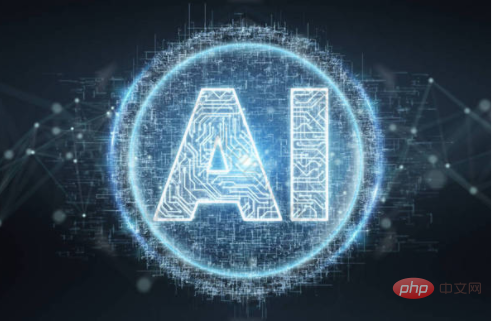
What exactly is artificial intelligence (AI)?
Artificial Intelligence , the English abbreviation is AI. It is a new technical science that studies and develops theories, methods, technologies and application systems for simulating, extending and expanding human intelligence.
The imitation of human intelligence processes by machines, especially computer systems, is called artificial intelligence. Expert systems, natural language processing, speech recognition and machine vision are several typical applications of artificial intelligence.
How does artificial intelligence work?
As enthusiasm around AI continues to grow, companies have been scrambling to show how their goods and services incorporate AI. What they call artificial intelligence is usually just one component of artificial intelligence, such as machine learning. AI requires specialized hardware and software to write and train machine learning algorithms. There is currently no single programming language that is synonymous with AI, but there are a few that stand out, including Python, R, and Java.
Artificial intelligence systems typically consume large amounts of labeled training data, evaluate the data for correlations and patterns, and then use these patterns to predict future states. By learning from millions of instances, a chatbot given text chat examples can learn to hold realistic conversations with humans. In contrast, image recognition programs can learn to recognize and describe items in photos.
Learning, reasoning and self-correction are the three cognitive functions that artificial intelligence programming focuses on.
Learning Process - This component of AI programming involves collecting data and developing rules to convert the data into usable information. These rules are called algorithms, and algorithms teach computer devices how to perform specific tasks step by step.
Inference Process - This area of artificial intelligence programming is concerned with choosing the best method to achieve a given result.
Self-Correction Program – This feature of AI programming is designed to continually fine-tune algorithms and ensure they deliver the most accurate results.
Understand the various types of artificial intelligence classification
Since artificial intelligence research aims to make computers imitate human functions, the extent to which an artificial intelligence system can replicate human skills is used as a classification of artificial intelligence standard. Therefore, artificial intelligence can be classified into one of several categories based on how well the machine compares to humans in terms of diversity and performance.
In such systems, artificial intelligence that is able to perform more human-like functions and has a comparable level of competence is considered more advanced. In contrast, AI with limited functionality and performance is considered more straightforward and less evolved.
Based on this criterion, artificial intelligence is usually divided into two categories. One classification is based on the similarity of AI and AI-enabled robots to the human mind, and their ability to "think" and even "feel" like humans. According to this classification system, there are four categories of AI or AI-based systems: reactive machines, limited memory machines, theory of mind, and self-aware AI.
Reactive MachineHas no memory and is task-specific. Like Deep Blue, the IBM chess software that defeated Garry Kasparov in the 1990s. Deep Blue can identify pieces on the chessboard and make predictions, but due to its lack of memory, it cannot use past experiences to influence future experiences.
Limited Memory - Because these artificial intelligence systems have memory, they may use previous experiences to guide future judgments. This is how some of the decision-making mechanisms for self-driving cars are created.
Theory of Psychology is a word used in psychology. When applied to artificial intelligence, this means that machines have the social intelligence to understand emotions. This kind of artificial intelligence can predict human behavior and infer human intentions, which is an essential ability for artificial intelligence systems to become integral members of human teams.
Self-awareness - Artificial intelligence systems in this category have a sense of themselves, which gives them consciousness. Self-aware machines know their current situation. Currently, this form of artificial intelligence does not exist.
However, an alternative classification scheme more commonly used in technical terms is to classify technologies as: artificial narrow intelligence (ANI), artificial general intelligence (AGI), and artificial superintelligence (ASI).
Narrow Artificial Intelligence (ANI)
This form of artificial intelligence encompasses all existing artificial intelligence, including the most complex and capable ones built to date AI. Narrow artificial intelligence means that an artificial intelligence system can only complete one task independently while showing skills similar to humans. These machines can only accomplish what they were designed to do, giving them a limited or narrow range of capabilities. According to the above classification, these systems involve all types of artificial intelligence that are reactive and have limited memory. ANI even includes state-of-the-art artificial intelligence, which uses machine learning and deep learning to train itself.
Artificial General Intelligence (AGI)
The ability of an artificial intelligence agent to learn, perceive, understand, and function exactly like a human being is known as general artificial intelligence. By mimicking our multi-functional abilities, AI systems will have the same capabilities as humans. These systems will be able to independently build a large number of capabilities and make connections and generalizations across domains, significantly reducing training time.
Super Artificial Intelligence (ASI)
The birth of Artificial Super Intelligence (ASI) will undoubtedly mark the pinnacle of artificial intelligence research, because ASI will become the most Intelligent forms of competitiveness. In addition to imitating human intelligence, ASIs will be better in everything they perform due to vastly increased memory, faster data processing and analysis, and greater decision-making capabilities. Advances in AGI and ASI will lead to a scenario called the Singularity. While it's tempting to have such powerful tools at our disposal, these devices can jeopardize our existence, or at least our way of life.
What is the difference between machine learning and deep learning?
Machine Learning is a subset or application of artificial intelligence (AI) that allows systems to learn and grow from experience without having to be coded to that level. Machine learning uses data to learn and get the right results. Machine learning involves creating computer software that reads data and uses it to learn from itself.
Deep learning is a subset of machine learning, including artificial neural networks and recurrent neural networks. It uses algorithms and their methods to solve any complex problem. Algorithms are built in the same way as machine learning. However, there are many more layers of algorithms. The algorithm's network is called an artificial neural network. In simpler terms, it simulates the working mode of the human brain because all neural networks in the brain are connected. This is the concept of deep learning.
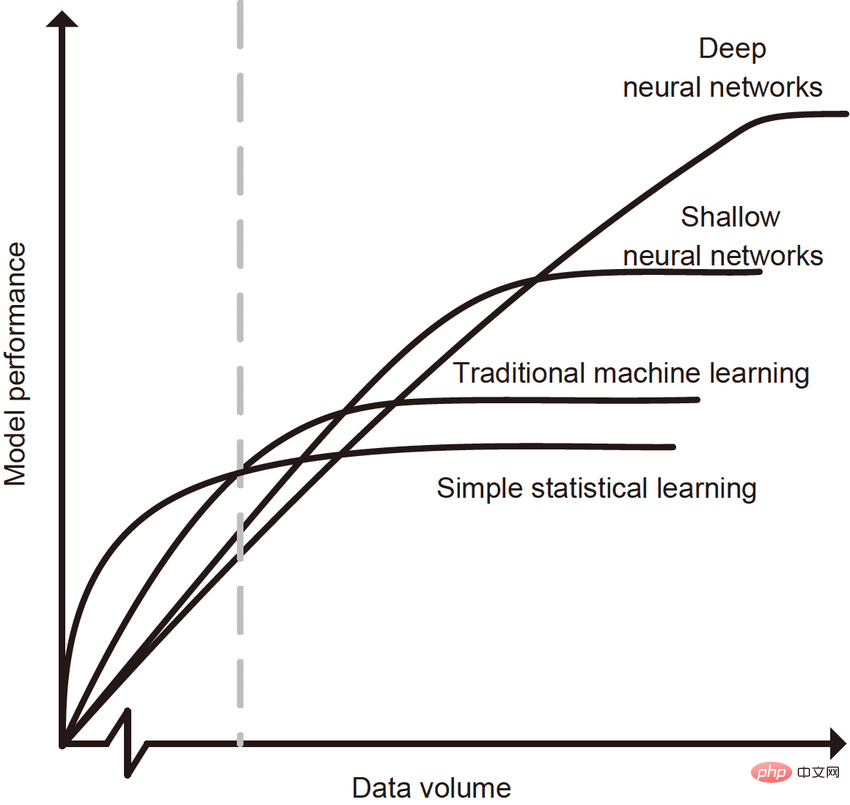
Relationship between the capabilities and data volume of simple statistical learning, traditional machine learning, and neural networks with various hidden layers
The following table compares machine learning to deep learning:
Machine Learning |
Deep Learning |
|
1 |
Machine learning is a superset of deep learning |
Deep learning Is a subset of machine learning |
2 |
##Machine learning data is very different from deep learning data. Because it uses structured data. | The data format for deep learning is much different because it uses neural networks (ANN). |
| 3 | Machine learning is the next step in the development of artificial intelligence | Deep learning is the next step in the development of machine learning. Essentially, it refers to the depth of machine learning |
| 4 | Thousands are used in machine learning Data points | Millions of data points make up big data |
| 5 | Output: numerical value, such as score classification. | Anything from numbers to free-form features such as free text and sounds is acceptable. |
| 6 | Various automated algorithms are used to convert inputs into model functions and predict future actions. | To analyze data features and relationships, a neural network is used that sends data through processing layers. |
7 |
Data analysts discover algorithms to evaluate certain variables in a data set. |
Once implemented, algorithms essentially describe themselves in data analysis. |
8 |
Machine learning is often used to stay ahead of the competition and learn new skills. |
Deep learning is used to solve challenging machine learning problems. |
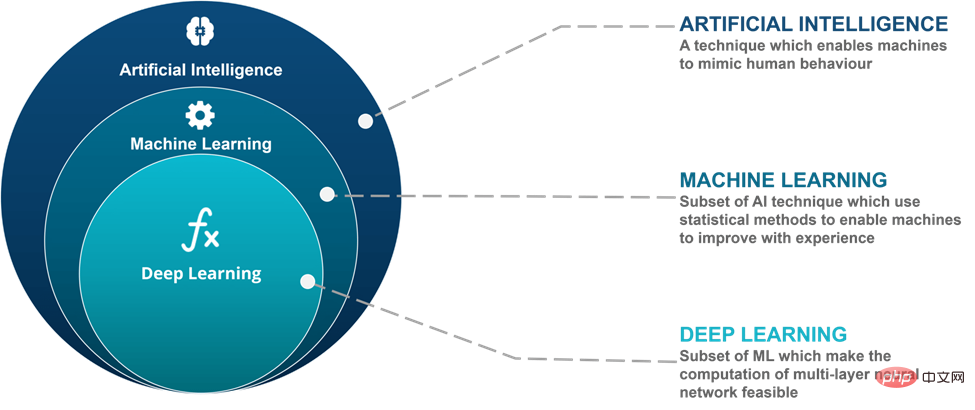
https://www.researchgate.net/figure/Relationship-between-the -capabilities-and-amount-of-data-of-simple-statistical-learning_fig1_340134117.
Global Artificial Intelligence Market Scale
In 2021, the global artificial intelligence (AI) market was worth US$87.04 billion and is expected to reach US$1,597.1 billion in 2030 and 2022 The compound annual growth rate to 2030 is 38.1%. The global COVID-19 pandemic has been extraordinary and alarming, with higher-than-expected demand for this technology across all sectors compared to pre-pandemic levels. It is estimated that the global market will grow by 150% in 2022 compared to 2019.
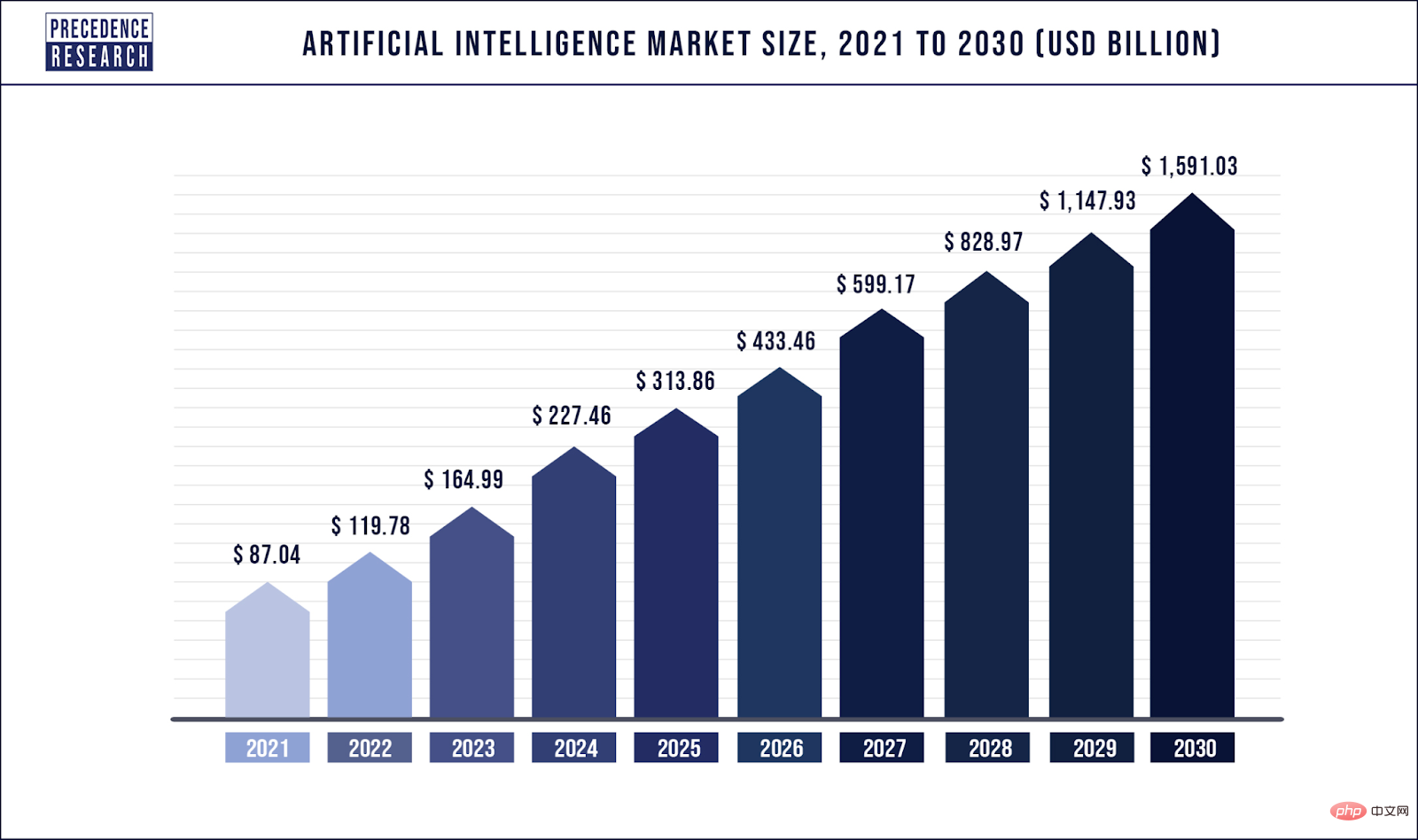
https://www.php.cn/link/7439aebdba054f0d586d486ef2aff185
Growth FactorsTechnological innovation has always been an important part of most industries. In recent years, the increasing popularity of digital technology and the Internet has greatly promoted the development of the global artificial intelligence industry. The huge expenditures on R&D by technology giants are constantly driving technological progress in various industries. Growing demand for AI technology across multiple end-use sectors such as automotive, healthcare, banking and finance, manufacturing, food and beverages, logistics, and retail is likely to drive the global AI market in the coming years. The increasing popularity of numerous medical devices and the autonomous driving capabilities of new electric vehicles are significantly driving the growth of the global artificial intelligence market. The global digitalization trend is having a favorable impact on the market growth. The world's top IT giants, including Google, Microsoft, IBM, Amazon, and Apple, are increasing their efforts to promote and develop different artificial intelligence applications. Efforts by tech giants to improve access to artificial intelligence are expected to drive the growth of the global artificial intelligence market over the forecast period.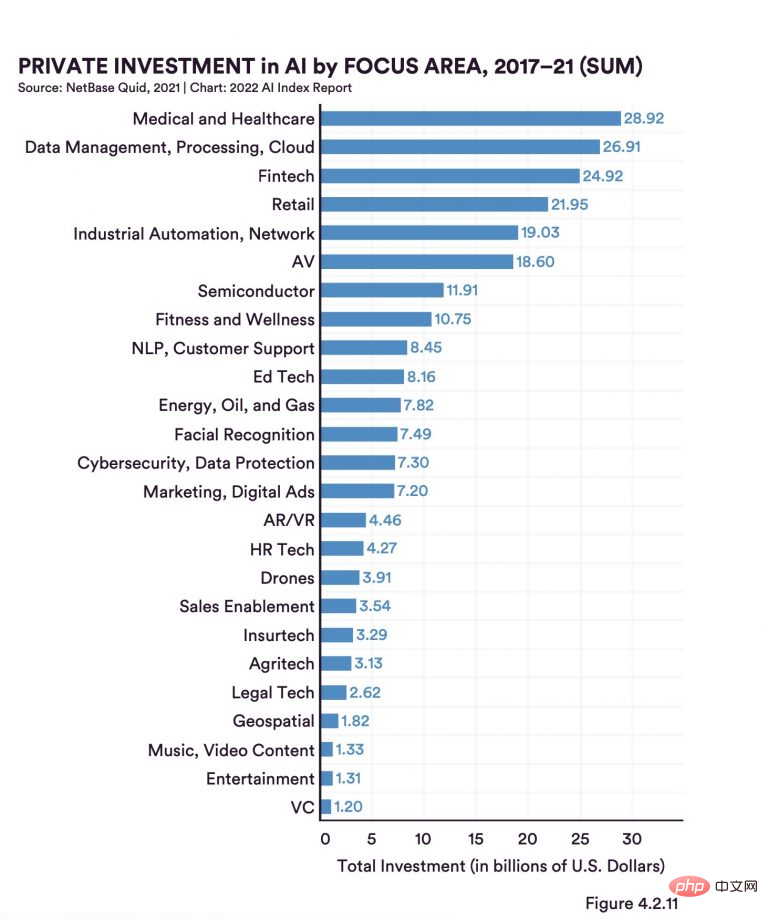
The above is the detailed content of Understand the past, present and future of artificial intelligence in one article. For more information, please follow other related articles on the PHP Chinese website!

Hot AI Tools

Undresser.AI Undress
AI-powered app for creating realistic nude photos

AI Clothes Remover
Online AI tool for removing clothes from photos.

Undress AI Tool
Undress images for free

Clothoff.io
AI clothes remover

AI Hentai Generator
Generate AI Hentai for free.

Hot Article

Hot Tools

Notepad++7.3.1
Easy-to-use and free code editor

SublimeText3 Chinese version
Chinese version, very easy to use

Zend Studio 13.0.1
Powerful PHP integrated development environment

Dreamweaver CS6
Visual web development tools

SublimeText3 Mac version
God-level code editing software (SublimeText3)

Hot Topics
 1382
1382
 52
52
 Centos shutdown command line
Apr 14, 2025 pm 09:12 PM
Centos shutdown command line
Apr 14, 2025 pm 09:12 PM
The CentOS shutdown command is shutdown, and the syntax is shutdown [Options] Time [Information]. Options include: -h Stop the system immediately; -P Turn off the power after shutdown; -r restart; -t Waiting time. Times can be specified as immediate (now), minutes ( minutes), or a specific time (hh:mm). Added information can be displayed in system messages.
 What are the backup methods for GitLab on CentOS
Apr 14, 2025 pm 05:33 PM
What are the backup methods for GitLab on CentOS
Apr 14, 2025 pm 05:33 PM
Backup and Recovery Policy of GitLab under CentOS System In order to ensure data security and recoverability, GitLab on CentOS provides a variety of backup methods. This article will introduce several common backup methods, configuration parameters and recovery processes in detail to help you establish a complete GitLab backup and recovery strategy. 1. Manual backup Use the gitlab-rakegitlab:backup:create command to execute manual backup. This command backs up key information such as GitLab repository, database, users, user groups, keys, and permissions. The default backup file is stored in the /var/opt/gitlab/backups directory. You can modify /etc/gitlab
 How to check CentOS HDFS configuration
Apr 14, 2025 pm 07:21 PM
How to check CentOS HDFS configuration
Apr 14, 2025 pm 07:21 PM
Complete Guide to Checking HDFS Configuration in CentOS Systems This article will guide you how to effectively check the configuration and running status of HDFS on CentOS systems. The following steps will help you fully understand the setup and operation of HDFS. Verify Hadoop environment variable: First, make sure the Hadoop environment variable is set correctly. In the terminal, execute the following command to verify that Hadoop is installed and configured correctly: hadoopversion Check HDFS configuration file: The core configuration file of HDFS is located in the /etc/hadoop/conf/ directory, where core-site.xml and hdfs-site.xml are crucial. use
 What are the methods of tuning performance of Zookeeper on CentOS
Apr 14, 2025 pm 03:18 PM
What are the methods of tuning performance of Zookeeper on CentOS
Apr 14, 2025 pm 03:18 PM
Zookeeper performance tuning on CentOS can start from multiple aspects, including hardware configuration, operating system optimization, configuration parameter adjustment, monitoring and maintenance, etc. Here are some specific tuning methods: SSD is recommended for hardware configuration: Since Zookeeper's data is written to disk, it is highly recommended to use SSD to improve I/O performance. Enough memory: Allocate enough memory resources to Zookeeper to avoid frequent disk read and write. Multi-core CPU: Use multi-core CPU to ensure that Zookeeper can process it in parallel.
 How to train PyTorch model on CentOS
Apr 14, 2025 pm 03:03 PM
How to train PyTorch model on CentOS
Apr 14, 2025 pm 03:03 PM
Efficient training of PyTorch models on CentOS systems requires steps, and this article will provide detailed guides. 1. Environment preparation: Python and dependency installation: CentOS system usually preinstalls Python, but the version may be older. It is recommended to use yum or dnf to install Python 3 and upgrade pip: sudoyumupdatepython3 (or sudodnfupdatepython3), pip3install--upgradepip. CUDA and cuDNN (GPU acceleration): If you use NVIDIAGPU, you need to install CUDATool
 How is the GPU support for PyTorch on CentOS
Apr 14, 2025 pm 06:48 PM
How is the GPU support for PyTorch on CentOS
Apr 14, 2025 pm 06:48 PM
Enable PyTorch GPU acceleration on CentOS system requires the installation of CUDA, cuDNN and GPU versions of PyTorch. The following steps will guide you through the process: CUDA and cuDNN installation determine CUDA version compatibility: Use the nvidia-smi command to view the CUDA version supported by your NVIDIA graphics card. For example, your MX450 graphics card may support CUDA11.1 or higher. Download and install CUDAToolkit: Visit the official website of NVIDIACUDAToolkit and download and install the corresponding version according to the highest CUDA version supported by your graphics card. Install cuDNN library:
 Detailed explanation of docker principle
Apr 14, 2025 pm 11:57 PM
Detailed explanation of docker principle
Apr 14, 2025 pm 11:57 PM
Docker uses Linux kernel features to provide an efficient and isolated application running environment. Its working principle is as follows: 1. The mirror is used as a read-only template, which contains everything you need to run the application; 2. The Union File System (UnionFS) stacks multiple file systems, only storing the differences, saving space and speeding up; 3. The daemon manages the mirrors and containers, and the client uses them for interaction; 4. Namespaces and cgroups implement container isolation and resource limitations; 5. Multiple network modes support container interconnection. Only by understanding these core concepts can you better utilize Docker.
 What are the security policies of php on centos
Apr 14, 2025 pm 02:33 PM
What are the security policies of php on centos
Apr 14, 2025 pm 02:33 PM
Detailed explanation of CentOS server PHP security policy: Building a solid protection system This article will explore in-depth how to build a secure PHP operating environment on the CentOS system, covering multiple aspects such as system level, PHP configuration, permission management, HTTPS encryption and security monitoring, etc., to help you effectively reduce the risk of server attacks. Server security is a continuous improvement process that requires regular review and updates to security policies. 1. System security cornerstone system update: Keep the latest version of the CentOS system and all software packages, install security patches in a timely manner, and plug known vulnerabilities. Firewall protection: Use Firewalld to finely control server network access, and only necessary ports (such as HTTP port 80 and H



